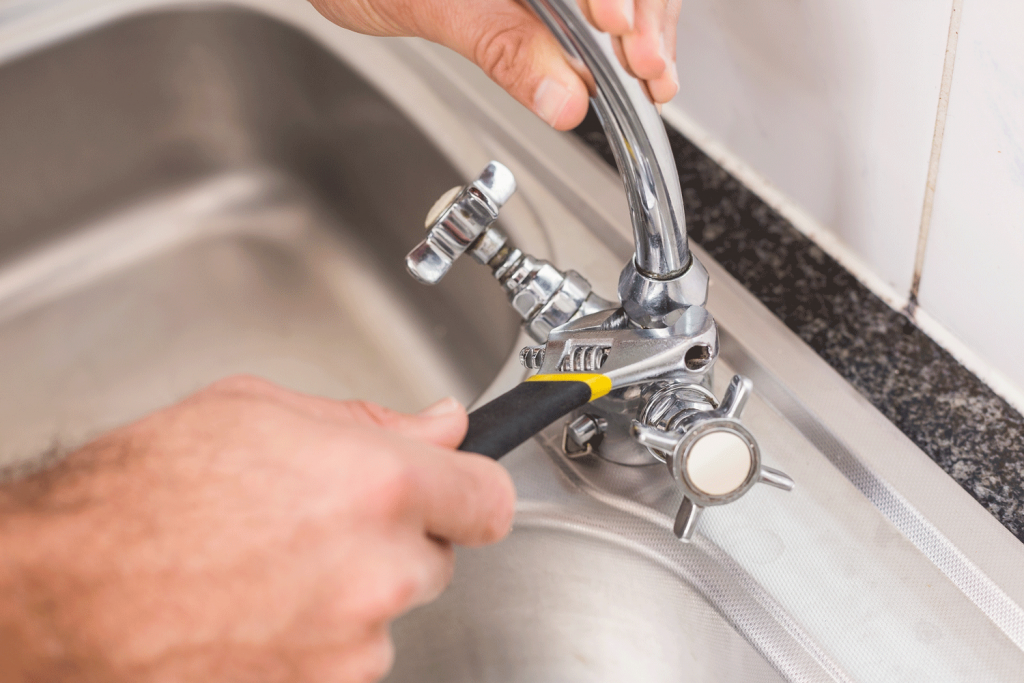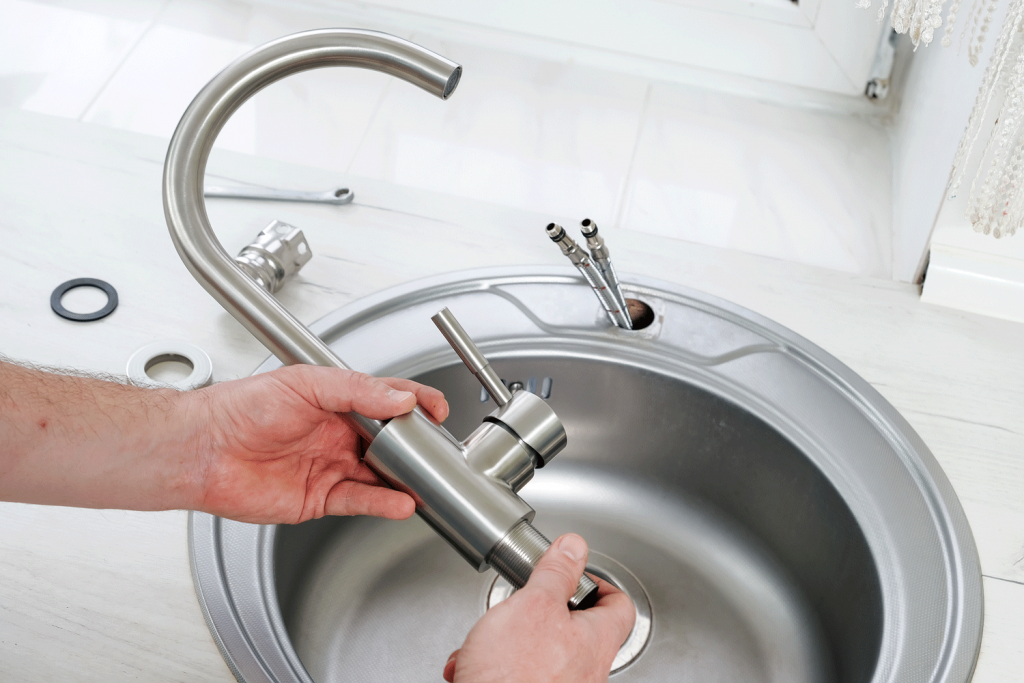Table of Contents
Swapping out or upgrading a dated faucet with an attractive, durable brass faucet that fits your sink, coordinates with your decor, and has the functional features you need is a great way to refresh your kitchen.
When you want to replace kitchen faucet, doing the job yourself can save you the cost and hassle of hiring a plumber. What’s more, you’ll be happy to discover that you can install the faucet in a few easy steps and enjoy a high-quality fixture that can provide you with reliable service for years to come.
How to Change a Kitchen Faucet: Gather Your Tools
When you’re planning to put in a kitchen faucet replacement, consider asking a friend or family member to help out with the job. This project is much easier to do with an extra set of hands. The first thing you’ll need to do is gather the faucet installation tools you’ll need. At minimum, you’ll need an adjustable wrench, a pan, some towels to catch water, plumber’s tape, and plumber’s putty. Investing in the full list of tools below is likely to make your job much easier and safer:
- adjustable wrench
- basin wrench
- pliers
- specialty tools or accessories the manufacturer provides
- silicone caulk or sealant
- plumber’s putty
- Teflon plumber’s tape
- a rag (to provide better grip)
- a bucket, pan, or bowl (to catch excess water)
- a plastic drop cloth (to protect your floor or cabinet from a leak or spill)
- towels
- a flashlight
- eye protection
- a cushion for your back (to make the work easier and more comfortable)
To ensure proper assembly of your new faucet, refer to its manufacturer’s instruction sheet. Clear out the area under your sink so you’ll have plenty of room to maneuver. If you have any electrical outlets near your sink or plumbing, cut off power to that circuit before you get to work.
How to Replace Kitchen Faucet: Remove Your Old Faucet
When you replace your old kitchen faucet, there are a few steps you’ll need to take:
Turn Off the Water Supply
Before you remove your old kitchen faucet, you’ll need to turn off the water supply. The shut-off valves for these cold and hot water lines are located underneath the sink. To stop the flow of the water, reach underneath the cabinet and turn the knobs or handles of the supply valves clockwise. If your kitchen plumbing doesn’t have these valves, you’ll need to turn off the main water supply to the house.
Check the condition of the supply lines and valves as you work. If a valve release seems too tight or if the supply lines drip, leak, or show excessive wear, you’ll want to replace them when you replace the faucet.
Disconnect the Water Supply Lines
Once you shut off the water, turn the faucet handles “on” to release any pressure in the supply lines, and place a towel on the floor to catch any drips. Use a wrench to disconnect the hot and cold supply lines from their corresponding valves by loosening the threaded nuts that connect these parts, then disconnect the lines from the faucet itself. For a better grip, try using a pair of pliers or a rag.


Remove the Mounting Hardware and the Old Faucet
After you disconnect the supply lines, you should remove the mounting nuts on the bottom of the faucet that secure it to the cabinet. To loosen the nuts, use your adjustable wrench or a basin wrench to turn them counterclockwise. If the hardware is stuck, apply an oil-based lubricant to help it release. Be sure to keep the connecting water pipe stable as you work.
Once you take off the mounting hardware, you can lift out the old faucet. Scrape, brush, or wipe away any dried caulk or residue from its mounting area. Use a plumbing- and sink-safe cleaning agent to scrub the area down, then let the area dry before you replace the faucet.
Replacing Kitchen Faucet: Installing the New Fixture
After you’ve removed the old faucet, you can get ready to install the new fixture by taking these steps:
Prepare the Sink and Install the Faucet
Before you install your new faucet, make sure that your fixture and your sink are compatible. If you have a single-hole sink, you’ll need a single-hole faucet. The details of the installation may vary depending on the model of the faucet, but in general, you’ll want to put silicone sealant around the mounting holes in the sink, align the faucet with the holes, press down, and maneuver the new faucet into its proper position.
You can ask your helper to straighten the fixture and hold it in place, or you can try using the wall or flat surface of the sink to keep it in the correct position as you fasten it down. Once the new faucet has been mounted, tighten its hardware and wipe away any excess sealant.
Connect the Water Supply Lines
After you secure your new faucet fixture, attach the faucet to the supply lines and their corresponding hot and cold supply valves. When you’re attaching the supply lines, be sure to first wrap Teflon tape clockwise around the threads so they will form a proper seal.
Replace the supply-line nuts by hand and tighten them with your wrench. Be sure that the pipe for the water supply valve is secure to protect any plumbing connections in the wall.
How to Put In Kitchen Faucet: Final Steps
Once your new faucet and water supply lines are properly installed, turn on the water supply and check for leaks from the supply lines and the faucet fixture. If you notice any drips, gently tighten any loose connections.
Next, remove the aerator from the fixture and turn on the faucet. Run the water for about 60 seconds, or long enough to flush any air and debris from the water supply lines and remove any blockages.
When you’re sure that the water is flowing properly, check again for leaks, turn off the faucet, and screw the aerator back into place. If everything is working well, then you have successfully installed your faucet.
Choose LESSO for All Your Kitchen Faucet Needs
When you’re looking for an attractive, high-quality replacement faucet for your kitchen, LESSO has you covered. Stop by our site today to browse our selection of single-hole and double-hole faucets for your home and enjoy the beauty and convenience they can bring to your home.
FAQs about Kitchen Faucet
Measure the distance between the holes in your sink to ensure compatibility.
Depending on your plumbing and faucet type, adapters may be necessary.
Over-tightening fittings and forgetting to turn off water supply are common errors.
Regular cleaning and checking for leaks can prolong faucet life.
Recommend Reading


When Should You Replace Bathroom Faucet?
Table of Contents A bathroom faucet is an essential fixture that we use every day. It’s easy to overlook its importance, but over time, wear


How to Clean Bathroom and Kitchen Faucets
Table of Contents Not many people realize that their faucets also require cleaning the same way as their sinks and other places in those rooms.








